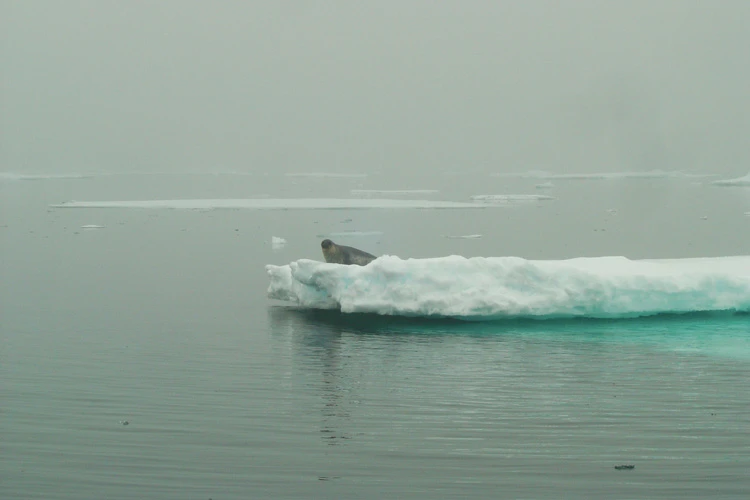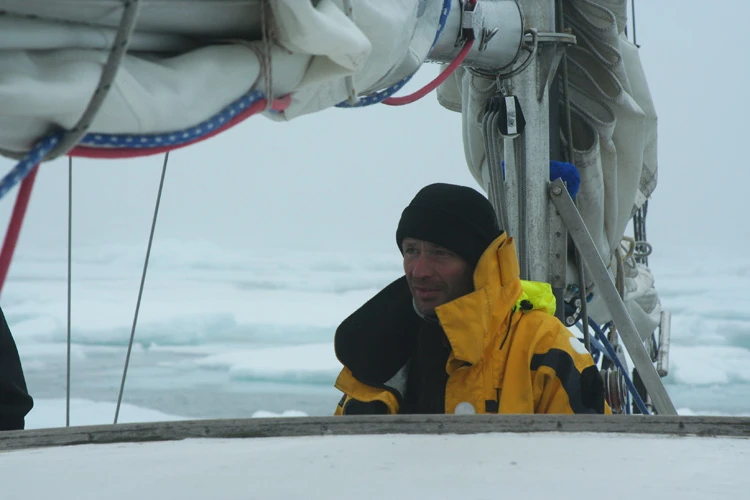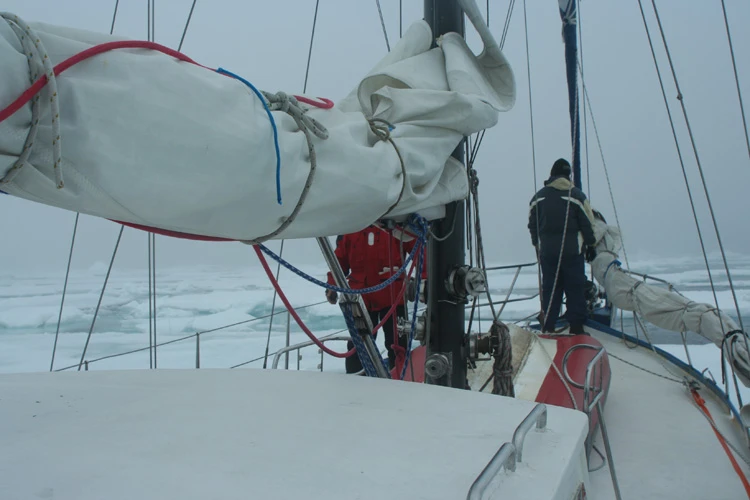When planning a sailing route far to the north, you can't just do as you wish. Above all, you must know what’s possible in a given area at a given time. In the comfort of home, sitting with my charts, it had never occurred to me that we might not even make it to Greenland's Scoresby Sund, the largest fjord in the world, by the end of June. Because of the severe weather, our journey was going to take an unexpected turn...
Voyage to Greenland's Scoresby Sund: the theory
In the Arctic Pilot it clearly states that the first ship may enter Scoresby Sound at the end of July and the last by the end of August at the latest, but I had planned to read it during the voyage when I had enough time to do so.
Therefore, it seemed to be a pretty good idea when one member of the crew, Radim (a participant in several previous challenging voyages) called me in mid-May to join us in Scoresby Sund. But as it began to become a reality, I began to browse servers about the state of the ice along the eastern shores of Greenland and discovered that everything was still completely frozen.
Should we sail into the impenetrable ice of the Greenland Sea?
I called Radim and announced our almost zero prospects of landing in Scoresby Sund. But I also told him we’d give it a try. As a bit of a joke, I advised him to try and order a helicopter and land at the edge of the ice sheet. We would wait for him and bring him on board. I added that he should borrow a rifle, just in case polar bears got there before us.
I didn't expect Radim to consider such nonsense. Radim, however, is a man of action and began gathering all the necessary information. He soon discovered that no one would take him to the ice sheet, but someone would actually lend him a rifle. So we made a deal.
We would try to reach Scoresby Sund, although it probably wouldn’t work, and Radim would fly there and promise not to get mad at us if we didn’t make it.
Before leaving the island of Jan Mayen, we requested a map at the weather station of the current state of the ice sheet around Greenland. We found out that ice floes extended 120 miles out to sea, and it was clear that they would not suddenly melt by themselves.
We called Radim to tell him to stay there. But Radim knew that Sund was completely frozen over and had already changed the plan. He had decided to hire a dog sled in Greenland for a few days. Of course with a rifle to protect against bears. And so he flew to Greenland.
We decided not to change the plan either and headed from the west coast of the Norwegian island of Jan Mayen to the Greenland ice sheet. It was about 150 miles due west. And since there was a southwesterly wind and we couldn't sail in any other direction anyway, we headed there.
Surrounded by the Greenland ice sheet and ice floes
I had studied everything I could find about sailing in ice and found that, with extreme caution, you can only sail when there is sea ice coverage of up to 40 % and that if the wind direction changes, the drift ice can completely close you in within an hour.
At 7 am on the second day of the voyage, we encountered our first small floating ice floes about 130 miles from Scoresby Sund. It was foggy with a slight wind, and we continued under sail, with a little help from the motor, through the still safely sparse floes.
The boat's engine suddenly went silent...
About a hour before the first ice floe appeared, I had switched the reserve diesel tank over to pump diesel into the main tank. Invariably, after a while, the diesel filter gets clogged, and then the motor has to be turned off and the filter cleaned or replaced. I do this only if there is no danger ahead.
This time, however, I hadn’t assessed the situation quite so well. At the first stagger in engine speed, I climbed into the engine room and turned it off. Meanwhile, inside the cockpit, Kos was calmly steering, and Míra was reading a message from his girlfriend on Iridium. After reading the message and replying, he looked up from the phone and was amazed to see that the drift ice had thickened dramatically and ice floes were drifting everywhere around us.
At that exact same moment, the engine stopped. Nervously on deck, he called out to me, asking what was happening with the engine and I calmly informed him that I was just cleaning the filter. But I did feel a certain urgency in his voice, so I asked him what was going on up there. Mira responded that ice floes were absolutely everywhere.
 Seal on an ice floe
Seal on an ice floeWe still had the genoa and the mainsail on the mast and a light wind was slowly pushing us into the ice. The crew took down the genoa, I sped up the filter cleaning and got the engine started again in no time at all. I climbed up on deck and there was indeed quite a lot of ice around. We estimated it to be about 20% to 30% coverage, which was still fine.
Zigzagging in the fog in a labyrinth of ice floes
Because of that, we chose not to leave the ice sheet immediately, we found our way out of the thickest of the ice slurry, turned and set a course of 220° in the direction of Iceland. This course was to run alongside the ice sheet. I consulted with our experienced polar explorer Vilém, and we agreed to gradually sail out of the fragmented ice sheet and return to it about 150 miles south. There should be a continuous compact ice sheet there and we could encounter polar bears.
For several more hours, we sailed on a course alternating between 90° and 220°, according to the preference of the current helmsman. But we still didn’t get out of the drift ice. We watched the seals lounging on the ice floes, and on one floe even saw bear's paw prints in the snow. The bear was nowhere to be seen.
The density of the drift ice fluctuated and alternated between relatively open passages to areas with denser coverage. The size of the ice floes had gradually increased and I was ready to leave the drift ice and get to open sea. We turned the boat in a purely easterly direction, which in our opinion was been the shortest way out, and took down the mainsail. Zigzagging in the fog between the ice floes began to resemble being in a maze.
I climbed to the first spreader to see if there were any channels in the ice to get out us of this mess. The visibility in the fog was about 1 mile, and it fluctuated erratically.
 Jirka Zindulka fully focused at the helm
Jirka Zindulka fully focused at the helm
Read about the weather you may encounter on the boat:
An impenetrable wall of ice floes closed in and gripped us in despair
I told Vilém at the helm where to turn, at the bow the crew guarded the distance from the ice floes and the stern as well. Vilém was doing a great job, but progress was very slow. We were trying to sail through the open channels between the ice floes, having to zigzag constantly. The drift ice was pretty closed in and at best it had 50% coverage.
I was happy to have chosen the steel SEALORD for our expedition. Occasionally the side or bow was thrust onto the ice, but the ship held its own. Our amazing icebreaker! And the 130-horsepower Mercedes engine also did a fantastic job of moving us back and forth.
We all stared at the field of ice, telling the helmsman where to sail. One said to the left, the other to the right, and a third to the back. It was a bit confusing, but I really didn’t know which way was best. One person would look at the direction on the GPS because after a few sharp turns in the fog we immediately lost our bearings.
Again, areas alternated between thinner and denser coverage, areas of hope and hopelessness. After a while, however, we always seemed to end up at a hopelessly impenetrable ice sheet. It was beginning to look pretty unpleasant.
Mira looked at the route on the chart plotter we had taken so far in the ice and, more importantly, where we had entered the ice. While the drift ice had resembled a sparse soup, here it was a dense, sometimes impenetrable slurry.
 On board the specially modified Sealord sailboat
On board the specially modified Sealord sailboat We decided to try and retrace our steps. The sea between the ice floes had completely calmed down and there were no waves. The wind was also very weak, but it had changed from southerly to northerly, which could have completely reformed the field of ice. We turned the boat around and motored for a while between the floes back along our route.
It was very difficult to manoeuvre in the ice. When heading back the SEALORD could only go to one side, and turning in such a small space between the ice floes was extremely difficult. I had a feeling of hopelessness at the mast because there was ice as far as the eye could see. Whenever we went where we wanted to go, there was dense ice everywhere.
Slowly we sailed back and the fog lifted a little. At starboard, I saw a patch of open water about 2.5 miles away, and it seemed that maybe the ice barrier was finally over. I called it down to the crew and told Vilém to head that way.
Mira climbed the rear mast and looked out at where the ice ended. The path to the open sea was not long, but it was completely impenetrable. There was no open channel through the ice. Only occasionally could we see water between the floes.
Exhausting struggle with the boat as an icebreaker
I called out to Vilém that we would have to use the floe as a battering ram to open up the way. But then I climbed down the mast and stood alone at the helm. I know this ship better than anyone and doing complex manoeuvres is no problem. I told Láďa to focus on a course to the open water.
Suddenly the fog closed in and we needed to know what direction to stick to. I was still considering whether to launch the liferaft and use it to help push the floes. But after consulting with Vilém, I dismissed the idea. We had to completely change our approach.
Until now we had been trying to find open water and move through it. But there was no open water. So it was necessary to create it ourselves. I told the crew to take their hooks in their hands and push away the ice floes. No one protested and the crew hooked up.
Even as I issued this command, I realized how ridiculous it was and I had to laugh. With a short hook, we couldn’t even reach the water, and the idea of pushing away tonnes of ice was ridiculous. But at least it was a command. It is important that the captain has a clear strategy when leading toward a goal :-).
 Mirek on the mast directing which way to sail
Mirek on the mast directing which way to sail From the mast, Mira gave me directions on how to stay where the drift ice was not so high and dense. Tomáš and Kos watched the bow and Láďa and Vilém the stern. Everyone was trying to take photos and Roman shot some video. Láďa remained careful to remain on course because the fog was getting dense again and the end of the barrier was in sight.
I manoeuvered the boat so that the bow slowly drove into the ice floes ahead. As soon as the bow dug into the floe, I gradually added throttle and the bow slightly slid, lifting a little onto the floe which slowly moved. With the rudder, I managed to partially correct rotation and the movement of the floe so that we inched the floe ahead of as like a battering ram.
The smaller floes we pushed away and the larger ones we pushed against. This way we managed to open up short channels in the ice, which we travelled through using complicated manoeuvring. The wind picked up a little and when manoeuvring slowly pushed us sideways against the ice floes. Again, the only way to manoeuvre was to push the bow against the floe and accelerate forward, turning the stern into position.
We inched slowly forward. The entire crew worked perfectly as a team. Although it was far from clear that we would get through this adventure unscathed, no one thought about it and just did their job. And all our guardian angels also did a great job.
We were about 2.5 miles from the sea when we saw the end of the ice barrier. Slowly, extremely slowly it began to diminish. Covering this distance took us almost 3 hours. We had to burn a lot of fuel doing it and push hundreds and hundreds of tonnes of ice.
Can we break free from the icy embrace?
The SEALORD proved itself beyond worthy, and its steel hull was something we could rely on. On the mast, Mira clearly determined our course, his calm voice helping to keep the entire crew calm, and we slowly worked our way towards the end of the ice barrier that looked extremely compacted.
We would never have willingly headed into that. Finally, we were pushing off the last big floe and the channels released us out into the open sea. The crew’s faces showed genuine relief. We had wanted to experience what it looked like in the drift ice, but this was not what any of us had imagined.
I asked Vilém how they had dealt with any similar situation in Antarctica, and he said that in his five Antarctic voyages, not once had he got into drift ice like that. But he did confirm that there was no other way we could have proceeded. In places, the sea coverage had been 70 to 90%, and according to the Arctic Pilot that is impenetrable ice.
After escaping the icy embrace, we retreated several miles from the edge of the ice and headed for Iceland. The fog lifted and we watched the glow of the ice on the horizon. In good visibility, this drift ice reflects the light and glows like an illuminated city in the distance.
It was a beautiful sight to see the receding ice barrier releasing us from its grip.
Author: Zindulka Jiří
Expedition specifics
Boat:
- SEALORD steel two-mast sailboat built for the demanding conditions of the Nordic seas. It’s a ketch that is 18 m long, 4 m wide and with a 2 m draught. It weighs 27 tonnes and it is powered by 110 m2 of sails and a 130 HP Mercedes engine. Overall, it is for 8 + 2 people.
Sails:
- Mainsail, aft mizzen sail, 2 forward furling genoas, 1 reefing genoa, 110 m² gennaker, 2 jibs, storm jib.
Route (this section of voyage):
- Iceland Akureyri, Hrisey Island, Grimsey Island, Jan Mayen Island far beyond the Arctic Circle, there is only one polar station with 18 members, ice sheet near Greenland, Iceland Westfjords Isafjordur
Length of voyage:
- 1400 NM
Sailing dates:
- 30/05 to 20/06/2010
Our range of boats in warmer destinations:
